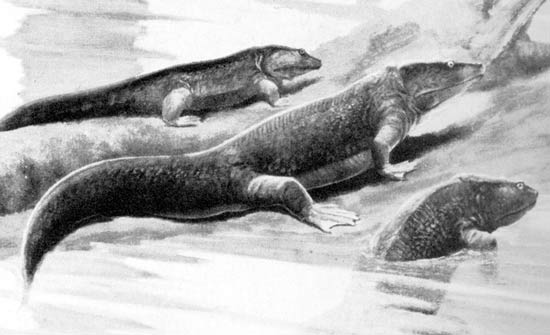Bigotry: The Dark Danger
Confessions of the Evolutionists

DOWNLOAD THE BOOK
CHAPTERS OF THE BOOK
- Introduction
- Chapter 1. Charles Darwin's Confessions Regarding His Theory
- Chapter 2. Evolutionists' Confessions Regarding Darwin
- Chapter 3. Evolutionists' Confessions Regarding the Invalidity of the Theory of Evolution
- Chapter 4. Evolutionists' Confessions Stating that They Espouse the Theory of Evolution for Ideological Reasons
- Chapter 5. Evolutionists' Confessions Stating that Natural Selection has No Evolutionary Power
- Chapter 6. Evolutionists' Confessions Stating that Mutations Have No Evolutionary Power
- Chapter 7. Evolutionists' Confessions Regarding the Dead-End of Molecular Evolution
- Chapter 8. Evolutionists' Confessions Regarding the Sudden Emergence of Life
- Chapter 9. Evolutionists' Confessions Regarding the Lack of Intermediate-Form Fossils
- Chapter 10. Evolutionists' Confessions Stating that There Is No Evidence of a Transition from Invertebrates to Vertebrates
- Chapter 11. Evolutionists' Confessions of the Impossibility of a Transition from Water to Dry Land
- Chapter 12. Evolutionists' Confessions of the Impossibility of Reptiles Evolving into Birds
- Chapter 13. Evolutionists' Confessions Stating That the Theory of Evolution Cannot Account for the Origin of Mammals
- Chapter 14. Evolutionists' Confessions Regarding the Invalidity of the "Horse Series"
- Chapter 15. Evolutionists' Confessions Regarding the So-Called Forebears of Man
- Chapter 16. Evolutionists' Confessions Stating that the Human Soul cannot Be Explained in Terms of Evolution
- Chapter 17. Evolutionists' Confessions Stating that Complex Organs cannot Appear by Way of Evolution
- Chapter 18. Evolutionists' Confessions Stating that the Theory of Evolution cannot Explain Animal Instincts
- Chapter 19. Evolutionists' Confessions Stating that Plants Cannot have Arisen by Way of Evolution
- Chapter 20. Evolutionists' Confessions Regarding Variations
- Chapter 21. Evolutionists' Confessions Stating the Non-existence of Vestigial Organs
- Chapter 22. Evolutionists' Confessions Regarding the Invalidity of the Claims of Homology
- Chapter 23. Evolutionists' Confessions Stating that the Evolution Theory Violates the Second Law of Thermodynamics
- Chapter 24. Evolutionists' Confessions Regarding the Invalidity of the Theory of Recapitulation
- Chapter 25. Evolutionists' Confessions Stating that Life Can Only Have Been Created
- Chapter 26. Materialists' Confessions Stating that the Universe Has a Beginning
- Chapter 27. Evolutionists' Confessions Stating that the Order in the Universe Cannot Have Come about by Chance
- Chapter 28. Evolutionists' Confessions Regarding Darwinism's Negative Effect on Moral Values
- Conclusion
< <
12 / total: 30
Chapter 11. Evolutionists' Confessions of the Impossibility of a Transition from Water to Dry LandThe evolutionist scenario further maintains that after a time, fish-which had evolved from invertebrates-developed limbs and turned into amphibians capable of living on dry land. But, as you might imagine, there is no evidence for such a scenario. Not a single fossil of a half-fish, half-amphibian creature has ever been found. The process of a transition from water to dry land espoused by evolutionists never happened. In addition to the complete absence of the fossils needed to indicate such a transition, a great many important changes would have had to take place for any living thing to move from water to land. But such a transition is impossible, and many factors make it so. For example, fishes' gills would have to turn into lungs for them to be able to live on land, and their fins would have to strengthen and lengthen into legs. Radical changes would also have to take place in a wide range of internal areas, such as energy consumption and the circulatory and excretory systems. Moreover, all these radical changes would have to take place at once for a creature moving from water to dry land to survive. But it is doubtlessly impossible for such physiological and anatomical changes to take place by chance and simultaneously. And evolutionists are in fact well aware of these impossibilities.
Hoimar Von Ditfurth is a German professor of neurology and psychiatry and a well-known evolutionist science writer:
Robert L. Carroll is the author of Vertebrate Paleontology and Evolution:
Edwin H. Colbert is an authority on paleontology and curator at the American Museum of Natural History, and M. Morales is the author of Evolution of the Vertebrates:
From the Encyclopedia Britannica:
Lewis L. Carroll is an evolutionist paleontologist and author of Vertebrate Paleontology and Evolution:
Robert L. Carroll is a vertebrate paleontologist and professor of biology at McGill University:
Footnotes227- Hoimar Von Ditfurth, Dinozorlar›n Sessiz Gecesi 2, ["The Silent Night of the Dinosaurs 2"] p. 149. 228- Robert L. Carroll, Vertebrate Paleontology and Evolution, New York: W. H. Freeman and Co., 1988, p. 4. 229- Robert L. Carroll, "Problems of the Origin of Reptiles," Biological Reviews of the Cambridge Philosophical Society, Vol. 44, No. 3, July 1969, p. 393. 230- Edwin H. Colbert, M. Morales, Evolution of the Vertebrates, New York: John Wiley and Sons, 1991, p. 99. 231- Encyclopaedia Britannica Online, "Turtle" 232- Lewis L. Carroll, "Problems of the Origin of Reptiles," p. 393. 233- Carroll, Robert L., Vertebrate Paleontology and Evolution, p. 138.
|
12 / total 30
You can read Harun Yahya's book Confessions of the Evolutionists online, share it on social networks such as Facebook and Twitter, download it to your computer, use it in your homework and theses, and publish, copy or reproduce it on your own web sites or blogs without paying any copyright fee, so long as you acknowledge this site as the reference.

